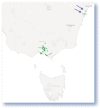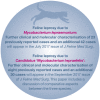Feline leprosy due to Candidatus 'Mycobacterium tarwinense':Further clinical and molecular characterisation of 15 previously reported cases and an additional 27 cases
- PMID: 28438086
- PMCID: PMC10816531
- DOI: 10.1177/1098612X17706467
Feline leprosy due to Candidatus 'Mycobacterium tarwinense':Further clinical and molecular characterisation of 15 previously reported cases and an additional 27 cases
Abstract
Objectives: This paper, the first in a series of three on 'feline leprosy', provides a detailed description of disease referable to Candidatus 'Mycobacterium tarwinense', the most common cause of feline leprosy in Victoria, Australia.
Methods: Cases were sourced retrospectively and prospectively for this observational study, describing clinical, geographical and molecular microbiological data for cats definitively diagnosed with Candidatus 'M tarwinense' infection.
Results: A total of 145 cases of feline leprosy were scrutinised; 114 'new' cases were sourced from the Victorian Infectious Diseases Reference Laboratory records, veterinary pathology laboratories or veterinarians, and 31 cases were derived from six published studies. Forty-two cats were definitively diagnosed with Candidatus 'M tarwinense' infection. Typically, cats were between 3 and 11 years of age, with no gender predilection, and were generally systemically well. All had outdoor access. Most cats underwent surgical resection of lesions with adjunctive medical therapy, often utilising a combination of oral clarithromycin and rifampicin for at least 3 months. Prognosis for recovery was generally good. Resolution of lesions was not observed in the absence of treatment, but a number of untreated cats continued to enjoy an acceptable quality of life despite persistence of the disease, which extended locally but did not appear to disseminate to internal organs. Preliminary results of draft genome sequencing confirmed that the species is a member of the Mycobacterium simiae complex.
Conclusions and relevance: Candidatus 'M tarwinense', a fastidious member of the M simiae complex, is capable of causing feline leprosy with a tendency to produce lesions on the head, particularly involving the eyes and periocular skin. The disease has an indolent clinical course and generally responds favourably to therapy despite lesions often containing large numbers of organisms. Detailed genomic analysis may yield clues as to the environmental niche and culture requirement of this elusive organism. Prospective treatment trials and/or drug susceptibility testing in specialised systems would further inform treatment recommendations.
Conflict of interest statement
The authors declared no potential conflicts of interest with respect to the research, authorship, and/or publication of this article.
Figures













Similar articles
-
Feline leprosy due to Candidatus 'Mycobacterium lepraefelis': Further clinical and molecular characterisation of eight previously reported cases and an additional 30 cases.J Feline Med Surg. 2017 Sep;19(9):919-932. doi: 10.1177/1098612X17706470. J Feline Med Surg. 2017. PMID: 28838294 Free PMC article.
-
Feline leprosy due to Mycobacterium lepraemurium.J Feline Med Surg. 2017 Jul;19(7):737-746. doi: 10.1177/1098612X17706469. J Feline Med Surg. 2017. PMID: 28592223 Free PMC article.
-
Feline leprosy: two different clinical syndromes.J Feline Med Surg. 2002 Mar;4(1):43-59. doi: 10.1053/jfms.2001.0151. J Feline Med Surg. 2002. PMID: 11869054 Free PMC article.
-
Feline mycobacterial infections.Vet J. 2014 Aug;201(2):230-8. doi: 10.1016/j.tvjl.2014.02.014. Epub 2014 Feb 25. Vet J. 2014. PMID: 24685470 Review.
-
Mycobacterium leprae and Mycobacterium lepraemurium infections in domestic and wild animals.Rev Sci Tech. 2001 Apr;20(1):219-51. doi: 10.20506/rst.20.1.1271. Rev Sci Tech. 2001. PMID: 11288514 Review.
Cited by
-
Ocular mycobacterial lesions in cats.Vet Pathol. 2022 Sep;59(5):792-805. doi: 10.1177/03009858221098431. Epub 2022 May 19. Vet Pathol. 2022. PMID: 35587045 Free PMC article.
-
Tuberculosis due to Mycobacterium bovis in pet cats associated with feeding a commercial raw food diet.J Feline Med Surg. 2019 Aug;21(8):667-681. doi: 10.1177/1098612X19848455. Epub 2019 May 13. J Feline Med Surg. 2019. PMID: 31082328 Free PMC article.
-
Feline leprosy due to Candidatus 'Mycobacterium lepraefelis': Further clinical and molecular characterisation of eight previously reported cases and an additional 30 cases.J Feline Med Surg. 2017 Sep;19(9):919-932. doi: 10.1177/1098612X17706470. J Feline Med Surg. 2017. PMID: 28838294 Free PMC article.
-
Cytokine and Chemokine Concentrations as Biomarkers of Feline Mycobacteriosis.Sci Rep. 2018 Nov 23;8(1):17314. doi: 10.1038/s41598-018-35571-5. Sci Rep. 2018. PMID: 30470763 Free PMC article.
-
Skin as a marker of general feline health: Cutaneous manifestations of infectious disease.J Feline Med Surg. 2017 Nov;19(11):1149-1165. doi: 10.1177/1098612X17735764. J Feline Med Surg. 2017. PMID: 29068251 Free PMC article. Review.
References
-
- Brown LR, May CD, Williams SE. A non-tuberculous granuloma in cats. N Z Vet J 1962; 10: 7–9.
-
- Allan GS, Wickham N. Mycobacterial granulomas in a cat diagnosed as leprosy. Feline Pract 1976; 6: 34–36.
-
- Lawrence WE, Wickham N. Cat leprosy: infection by a bacillus resembling Mycobacterium lepraemurium. Aust Vet J 1963; 39: 390–393.
-
- Schiefer B, Gee B, Ward G. Disease resembling feline leprosy in Western Canada. J Am Vet Med Assoc 1974; 165: 1085. - PubMed
-
- Wilkinson GT. A non-tuberculous granuloma of the cat associated with an acid-fast bacillus. Vet Rec 1964; 76: 777–778.
MeSH terms
Substances
LinkOut - more resources
Full Text Sources
Other Literature Sources
Medical
Miscellaneous

